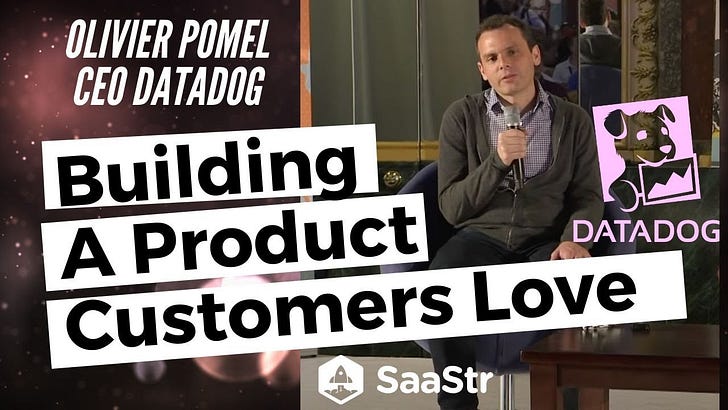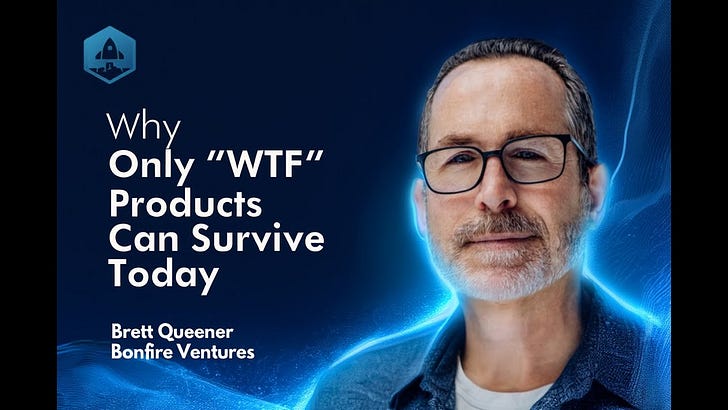A SaaStr Annual + AI Summit conversation with Jesse Zhang, CEO of Decagon, and Sarah Ittelson, Partner at Accel
Decagon Today: The Numbers Behind the Hype
Founded in late 2023—just months after GPT-4’s release—Decagon has become one of the fastest-growing AI companies in history. The company builds AI customer service agents for large enterprises, automating conversations that previously required human support teams.
The Growth Trajectory:
Founded: Late 2023
Time to Eight Figures ARR: ~18 months
Team Size: ~100 people (and scaling rapidly)
Location: 100% in-person team
Customers: Major enterprises including Hertz, Chime, and other leading brands
Typical Customer ROI: $800K in savings for every $250K spent
Market Position: Recognized as the leading Gen-AI native solution in customer service automation
What Makes This Growth Unprecedented:
Even by venture standards, this is exceptional. Sarah Ittelson, the Accel partner who led their Series A investment, has been part of the hyper-growth phases at Uber, Uber Eats, and Fair. Her assessment? “This current moment and the scaling that’s possible within these AI companies is unparalleled to even those hyper-growth moments of before.”
When Accel invested at the Series A, Decagon was targeting seven figures. By the time Jesse and Sarah took the stage at SaaStr to share their playbook, they’d already blown past eight figures. The headline had to be updated mid-flight.
This isn’t a story about getting lucky in a hot market. It’s a masterclass in intentional decision-making, relentless customer focus, and building a machine that compounds growth. Let’s unpack exactly how they did it.
The Market Selection Framework: Why Customer Service Won
Here’s the reality most founders miss: your growth rate is mostly determined by which market you’re in.
Jesse and his co-founder didn’t just pick customer service because it seemed like a good idea. They ran a rigorous discovery process—talking to roughly 100 potential customers over the course of a month. Every day packed with customer conversations. Every night cranking out product to show the next day.
What made customer service the winner?
Clear, measurable ROI: Companies could point to specific dollar savings. Spend $250K, save $800K in human support costs. That’s not a pitch—that’s math.
Massive TAM: Customer service is one of those rare markets where the surface area is enormous. Every large company has support teams. Every user interaction is a potential automation opportunity.
Buyer urgency: Unlike many SaaS categories, companies were willing to move off schedule to adopt AI solutions. The business case was too compelling to wait for the next budget cycle.
The key insight: they weren’t looking for a market where AI could work. They were looking for a market where companies were already bleeding money on a problem that AI could solve today.
The Customer Discovery Process: 100 Conversations Before a Single Line of Code
Let’s get tactical about how Decagon approached early customer discovery, because this is where most founders either win or waste months.
The Daily Cadence:
Pack every day with as many customer conversations as possible
Extract commitments: “If we built this, how much would it be worth to you?”
Build at night based on what you learned during the day
Show it to customers the next day
Iterate ruthlessly
What They Were Really Listening For:
Not excitement. Not validation. They were listening for willingness to pay.
Here’s Jesse’s framework: You could talk to the wrong person who feeds you useless feedback. Or you could talk to someone who’s super excited about your pitch, but when you get to pricing, there’s nothing there. True discovery means being aggressive about understanding what customers actually value and what they’ll actually pay for.
The Anti-Pattern They Avoided:
Jesse’s previous company was a consumer startup (eventually acquired by Niantic). The biggest lesson? They spent too much time sitting by themselves thinking about good ideas, building them, launching, and getting zero traction. That’s the burnout loop.
With Decagon, they flipped the script: talk first, build second, validate constantly.
Staying Close to Customers at Scale
Here’s where it gets interesting. Most companies do customer discovery well early, then lose touch as they scale. Decagon hasn’t.
How they maintain customer intimacy:
Weekly touchpoints with every customer (they work only with larger customers, which makes this feasible)
Proactive outreach—don’t wait for customers to complain
The entire team stays involved in go-to-market, not just sales
The principle: customers might not proactively tell you what’s missing. You have to pull it out of them. You have to understand what’s next on the horizon before they fully articulate it.
Building the Team: Why In-Person and Intelligence Matter
When Sarah Iden first met with Decagon, Jesse was closing employee number five. Even at that stage, the focus on talent was exceptional.
The Decagon Team Philosophy:
They’re essentially 100% in-person. That’s not an accident—it’s a forcing function for the culture they wanted to build.
What They Screen For:
Raw intelligence and adaptability: At the early stage, there’s no structure. No playbooks. No one hands you a to-do list. You need people who can figure it out.
Commitment level: This is the non-negotiable with co-founders and early employees. There’s a wide range in how committed people are to being a founder or early-stage employee. If it’s not aligned, nothing else matters.
Working style alignment: Are people working at the same pace? Putting in similar time? Gearing toward the same goals?
The Interview Process:
They ask about past experiences: “Tell me about a project where you invested the most time in your life.” They look at favorite projects, how hard people worked, the pace they maintained. They get back-channel references. By the time someone reaches the final interview with Jesse, they’ve already opted into the in-person culture and the intensity.
There’s no hard sell needed. The screening has done its job.
The Co-Founder Equation: Finding Your Match
Jesse’s co-founder relationship formed through A16Z (who backed his previous company) and mutual friends. But the chemistry wasn’t luck—it was alignment on fundamentals.
What Must Align:
Similar life stage
Level of commitment (the absolute non-negotiable)
Working style and pace
Type of company you want to build
Amount of time you’re willing to invest
What Can Differ:
Specific skill sets
Personality traits (to a degree)
The Best Way to Find Out:
Build something together. Do a trial. If you’re considering co-founding, you probably have the time to experiment. This is unique to co-founder dating—you can’t get this kind of trial when hiring someone with a full-time job.
The trial will surface everything: working style, commitment level, how you handle disagreement, pace of execution. Everything else is just conversation.
The Execution Culture: How to Maintain Intensity at 100 People
In the early days, execution culture is easy. Everyone’s in one room. You’re talking constantly. Alignment is organic.
At 100 people, it requires systems.
Decagon’s North Star Approach:
Everyone needs to know what they’re working toward. If you’re in sales or engineering, you need clear goals aligned in the same direction. If you’re not working toward one of the important goals, you’re probably not working on something important.
The Metrics That Matter:
For a SaaS company, it’s simple:
ARR
Customer count
Customer quality
These are measurable. They become the north star everyone marches toward.
The Celebration Cadence:
They celebrate wins constantly:
Customer gives great feedback
Customer goes live
Deal closes
Customer renews for two years
Every win gets shared. The team knows what they’re working toward and they see the impact in real-time.
The Challenge Ahead:
Jesse’s candid about this: they’re still figuring out how to maintain this culture as they scale. Right now they’re about 100 people and growing quickly. At some point, you can’t maintain culture just by talking. You need systems. They’re actively building those now.
The AI-Native SaaS Motion: Why Everything’s Different
Here’s what’s fundamentally changed about selling SaaS in the AI era:
1. ROI Must Be Provable and Fast
You can’t hand-wave anymore. Customers expect to test and see real ROI. For Decagon, that means:
Quantifiable conversation resolution rates
Measurable cost savings
Improved customer satisfaction scores
If both cost savings and CSAT are going up, the business case sells itself. They’re saving money AND customers are happier. That drives future revenue and retention.
2. Deployment Can Be Incremental
You don’t have to deploy all at once. Pick one surface area. Deploy to 10% of your customer base. Get live in production. If it works, ramp up.
This makes buying cycles shorter and happens more frequently because you’re not waiting for massive projects with perfect test cases before commercial discussions begin.
3. The Technology Layer Keeps Changing
Models are improving constantly. New techniques emerge. You have to build with the assumption that everything underneath will change.
How Decagon Handles This:
Build for model flexibility—instant evaluation and swapping of new models
Own the application layer (the final product customers buy)
Focus on solving the business problem, not showcasing the technology
The business problem doesn’t change even as technology evolves. That’s the power of building at the application layer. You’re evaluated on solving the problem, and as technology improves, your product improves automatically.
Breaking Through the Noise: Product Marketing in a Hyped Category
Every company is being told to have their “AI narrative.” So how does Decagon cut through?
Message #1: Gen-AI Native
Customer service has a long history of automation. The natural question is: “How are you different from existing solutions that are now adding Gen-AI?”
Decagon’s answer: They built from the ground up for Gen-AI. The entire paradigm of how you build these agents is different. You can do fundamentally more when you’re not retrofitting Gen-AI onto legacy architecture.
Message #2: Real ROI with Real Customers
AI is hyped. But Decagon has case studies with companies like Hertz and Chime showing:
Specific dollar savings
Support team repurposing
Higher NPS and retention
The message isn’t “AI is cool.” It’s “AI actually works here, and here’s the proof.”
Goal Setting: Maintaining Healthy Dissatisfaction
Despite the eight-figure run rate and explosive growth, there’s no back-patting at Decagon.
Why:
The market is massive. They’ve touched a fraction of a fraction of it. No one feels like they’ve achieved the goal yet.
The final vision: working with the biggest companies out there, deployed across entire surface areas, handling the entirety of customer interactions.
When your goal is that far in the future, it’s easy to stay hungry. There’s always so much more to do.
The Meta-Lesson: Market Selection Trumps Everything
Jesse’s closing advice deserves its own section because it’s the thread running through everything:
Pick the right market.
Within SaaS, if you can find a market with the right properties—clear ROI, measurable outcomes, large TAM, buyer urgency—it makes everyone’s life easier. The structured nature of SaaS (concrete customers, measurable revenue) compounds when you’re in the right market.
His previous consumer company could grow faster but had way less structure, higher variance, and no single customers paying meaningful money that you could talk to deeply.
The lesson: founder-market fit matters, but so does market-outcome fit. Choose a market where the fundamentals work in your favor.
The Q&A: How to Break Into Enterprise Customers
Question from audience: “How do you actually get those first customer conversations? How do you connect with companies like Rippling or Notion?”
Jesse’s Answer:
Find companies known for working with startups. Rippling is one. Then find the shortest path in:
Maybe your friend knows someone
Maybe your VC knows someone
Maybe it’s two hops away
Do it enough and you’ll get through. Maybe the first person isn’t right, but their coworker has a use case. It’s about finding the shortest path and doing it again and again.
When they were starting, they aggressively lined up conversations with literally anyone who would talk to them. That’s just what you have to do.
The Bottom Line
Decagon’s story isn’t about luck. It’s about:
Choosing a market where ROI is measurable and urgent
Talking to 100 customers before writing code
Building a team that reflects founder values and commitment
Maintaining customer intimacy even as you scale
Creating an execution culture with clear north stars
Building for flexibility as AI technology evolves
Staying hungry no matter how fast you grow
Zero to eight figures in 18 months is extraordinary. But the playbook is surprisingly replicable: pick the right market, talk to customers obsessively, hire for intensity and intelligence, execute relentlessly, and never stop pushing forward.
The AI-native SaaS wave is real. But winners won’t be determined by who has the best models or the most hype. Winners will be determined by who executes this playbook most effectively.
Decagon is showing us how it’s done.








